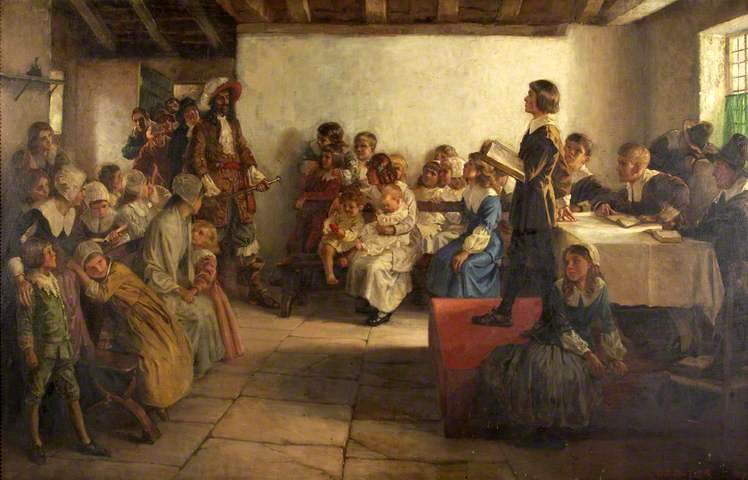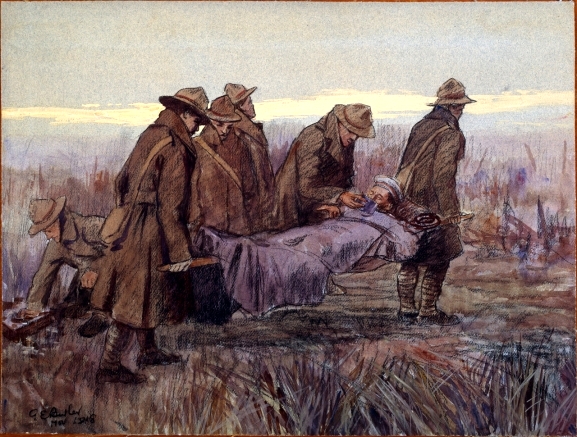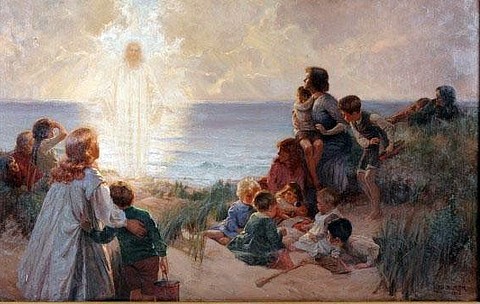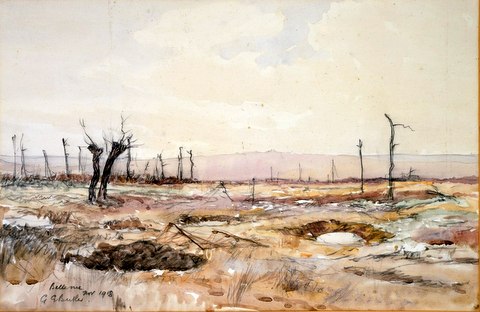BUTLER, George Edmund
George Edmund Butler was born at Home Cottage, South Stoneham, Southampton, Hampshire on 15 January 1872, son of Joseph Cawte Butler (2 October 1843-19 September 1924), a builder, and his wife Jane née Tiller, who married at Southampton in 1866. In 1881, George was a 9-year-old, living at Home Cottage, South Stoneham with his parents, 37-year-old George and 37-year-old Jane, with five sibling sisters, Jane 14, Ada Fanny 11, Annie Bertha 6, Winifred Isobel 4 and Harriett Amy 2, all born at Southampton. In 1883 the family emigrated to Wellington, New Zealand and, after young George had completed his education at Te Aro School, he worked for his father and from 1890, studied art part-time under James MacLauchlan Nairn (1859-1904) at the Wellington School of Design. In 1892, he joined the avant-garde Wellington Art Club, founded by Nairn, and soon established a local reputation for his paintings of seascapes. In 1897 Butler, and the Wellington art dealer McGregor Bonar Wright (1861-1939), went to Sydney to study pictures in the National Art Gallery of New South Wales and afterwards studied abroad at Lambeth School of Art in London, the Académie Julian in Paris, where he gained honours, and at the Royal Academy of Fine Arts Antwerp, winning a gold medal and laurel wreath in 1900. Whilst in England he married at Lyndhurst, Hampshire on 29 April 1899, his first wife, Sarah Jane Popplestone and their daughter was Bérénice Butler who was born in New Zealand in 1901. In 1900, Butler returned to Wellington and in that year exhibited in Wellington and the Christchurch Art Society exhibitions. The following year he settled in Dunedin and exhibited from there until 1905, and his paintings won praise at the Otago Art Society exhibitions, and he made his living by giving tuition in drawing and was commissioned to complete several portraits of city dignitaries. In 1905 he returned to England and settled in Bristol, teaching art at Bristol School of Art. After establishing a reputation as a portrait and landscape artist in oils and watercolours, in 1912 Butler was elected to the Royal West of England Academy and exhibited at the Royal Academy; the Royal Scottish Academy and the annual salon exhibition at the Société des Artistes Français in Paris. At the outbreak of the First World War, the New Zealand Expeditionary Force War Museum appointed him official New Zealand war artist with the honorary rank of captain, and he joined the New Zealand Division in France. After demobilisation on 31 December 1918, Robert Heaton Rhodes (27 February 1861–30 July 1956) and Major General Sir Andrew Hamilton Russell (23 February 1868–29 November 1960) privately commissioned Butler to paint a series of senior officer portraits and several large landscapes of New Zealand battlefield sites along the Western Front, these were purchased by the New Zealand Government. Butler never returned to New Zealand and lived at The Studio, Bath Road, Felixstowe, Suffolk where his wife Sarah died on 15 March 1928. A member of the Ipswich Fine Art Club 1923-1929 and exhibited from The Studio, 77 Henley Road, Ipswich in 1923 five oil paintings, 'The Garden of Childhood', 'Homeward', 'Portrait', 'Feeding the Fowls' and 'Spring'. After his second marriage on 29 April 1929, to Monica Susan Boyce (1877-1966), he returned to live in London. George Edmund Butler died at Twickenham on 9 August 1936, survived by his second wife and the two children from his first marriage, Bérénice and Brian. He signed his works 'G. E. Butler' in block letters with a date.
Royal Academy Exhibits
from Dunedin, New Zealand
1904 128 I Shall go Softly all my Years
from 92a White Ladies Road, Clifton, Bristol
1908 921 At Close of Day
from Woodcroft, Eastfield Road, Westbury on Trym, Bristol
1912 466 The Sunny Pathway
from 3 Beaufort Buildings, Clifton, Bristol
1915 476 The Golden Hour
1917 211 The Supreme Sacrifice
738 Dawn. 'For we have seen his star in the East'
from The Studio, 77 Henley Road, Ipswich
1923 9 The Builder's Barn
87 The Barn'
Works by This Artist

|
For the Faith of Their Fathers, Bristol, 1682Oil on canvas
|

|
Stretcher Party, November 1918Charcoal wash
|

|
The Shining PathwayOil on canvas
|

|
Bellevue RidgeCharcoal and wash on paper
|